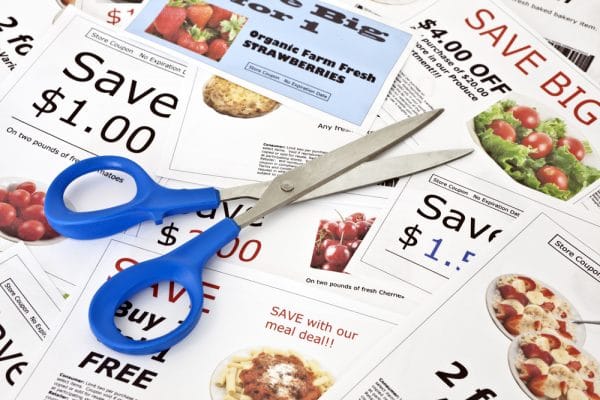While discounts and coupons are useful ways to stretch a dollar, a little scrutiny is justifiable before clipping, printing, or buying.
If cost is the only focus, forgoing a commitment to healthy food choices, we may be sacrificing our waistline for a budget line.

What Is The Real Cost of Coupons?
Costly-savings almost sounds like an oxymoron kind of doublespeak. You’ve probably already figured out how to avoid the lure of advertisements with “up-to” sales, drawing you in to spend money on things you don’t really need.
However, food is different—everyone needs to eat, right? Based on the number of apps touting the success of using grocery coupons, one would assume it is always a win-win. You have to buy the food anyway, right?
Well, yes and no. We have to eat, but we don’t have to eat what advertisers tell us to eat.
As consumers, we need to understand that coupons are a form of advertising, so it is up to us to be well informed. Many of the food products promoted by coupons are convenience foods void of nutrition value.
Even if you have made peace with the toxic ingredients in cleaning products, it’s hard to ignore the effects of sugar, sodium, carbohydrates, and preservatives in the processed foods that fill our shopping apps.
What might be convenient now, becomes time-consuming later when our immune system is compromised, the pounds pile on, or our children are hyperactive.

What Are We Really Saving?
In a Good Morning America report Money-Saving Tips From Coupon Queen, it was not surprising to see her pantry full of Cocoa Puffs, Fruit Loops, Rice-A-Roni, brownie mixes, and a host of other prepackaged products.
When you check the ingredients of these common processed and packaged foods you find monosodium glutamate (MSG), hydrogenated oils, and preservatives like BHA and BHT, high fructose corn syrup, hydrolyzed vegetable protein, and artificial colors.
These fillers and preservatives line grocery store shelves in myriad products. Of course, we want to be able to eat something other than a salad every night; it’s just not worth the savings at the register if the cost is our health. Manufacturers are happy to also provide a coupon for allergy medicine, glucose testers, sleep-aids, and prescription services too.
Buying cheaper food products with poor nutritional value becomes more costly over time when you add up doctor co-pays, lost time at work, or prescription refills.
To meet the increasing demand of tighter budgets, more and more companies are offering on-line discounts or coupons to print at home. And even though some companies are making coupons less consumer-friendly, consumers continue to respond.
It is a way for them to protect their bottom line while passing on the perception of a good deal.
Our Own Food Coupon Story
In my early years of clipping, my achiever personality kicked in, so I had a coupon for just about everything. Unfortunately, I bought things I didn’t need and paid no attention to the quality of the food choices because of the “savings” and the feeling of accomplishment.
It wasn’t until a family member was diagnosed with type 2 diabetes that I began to research the impact of food choices on our health and well-being. Our food philosophy changed and now I am far more selective with coupons, making them work for both our financial and physical gain.
You don’t have to become a nutritionist to understand food labels. Any label that lists ingredients you don’t recognize should raise concern. Check the ingredient list below of a common food item like sour cream.
This is just one example of the stark difference between products and the diligence required to choose well for our family and ourselves.
- Daisy brand: Grade A cultured cream
- Other store brand: cultured cream, grade A whey, modified food starch, sodium phosphate, sodium citrate, guar gum, carrageenan, calcium sulfate, potassium sorbate (preservative), and locust bean gum
Understanding just three diet-related areas—fats, grains, sweeteners—can make a significant difference in your diet and health. In fact, there are a few rules of thumb to follow to recognizing their various names and simplify the decision-making process.

How to Read Ingredient Labels for The Better Deals
Fats and Oils
Fats are a vital part of our diet which is why some are called essential. The food industry often uses chemically treated, cheap oils in food products in order to keep costs down.
The way in which fats are extracted and treated makes a great difference to our health and is an important aspect to research beyond the latest headlines.
- Avoid: hydrogenated or partially hydrogenated, “light” olive oil, shortening, margarine
- Look For: butter, expeller-pressed oils, extra virgin olive oil, unrefined coconut oil, *flaxseed oil, *grape seed oil, *walnut oil
TIP: Never cook with delicate oils like grape seed, flaxseed, walnut, or any omega 3 oil
Grains
Whole grains are an important part of a healthy diet but have been avoided in recent years because of high-protein/low-carb fad diets. Distinguishing between simple carbs and complex carbs makes a difference in the way they provide fiber and affect blood sugar.
- Avoid: Foods labeled with the words wheat, multi-grain, stone-ground, 100% wheat, cracked wheat, seven-grain, or bran, as they are usually not whole-grain products.
- Look For: The word “whole” should precede the type of grain product such as whole wheat, whole oats, or whole rye. Other good complex carbohydrates are oatmeal, brown rice, wild rice, barley, amaranth, millet, and quinoa.
Sugar and Sugar Substitutes
Addiction to sugar and sugar substitutes is evident in the sheer number of products that have been developed to indulge our habit. Limiting sugar, even natural sugars, in our diet is a crucial step in improving health and vitality.
High fructose corn syrup has taken the spotlight in recent years, but whether it is fructose, sucralose (artificial sweetener), glucose, or sucrose, the negative effects of sweeteners on our health should be taken seriously.
Agave nectar is relatively new on the health food scene. However, few consumers are aware of the chemical processes necessary to produce the product, which is why it’s not listed below.
- Avoid: high fructose corn syrup, refined sugar, artificial sweeteners of any kind
- Look For: unrefined honey, succanat, palm coconut sugar, stevia

Organic vs. Non-Organic
Whether you are environmentally conscious or simply trying to avoid chemicals on every leafy green that passes your plate, organic produce is an excellent choice for the 5 recommended servings per day.
If you’ve never paid much attention to organic vs. conventional, here is a quick list to get started without breaking the bank. These are commonly referred to as the “Dirty Dozen“: celery, peaches, strawberries, apples, blueberries, nectarines, bell peppers, spinach, kale, cherries, potatoes, grapes (imported).
Conversely, to leave a little more room in your food budget while avoiding the pesticides, there are conventionally grown fruits and vegetables referred to as the “Clean 15“: onions, avocado, sweet corn, pineapple, mango, sweet peas, asparagus, kiwi, cabbage, eggplant, cantaloupe, watermelon, grapefruit, sweet potato, honeydew melon.
Here’s 10 more ways to save money on organic produce.
Remember, it is important to wash all produce before eating, organic and conventional, alike—more than just wax or residues can lurk on the surface.
TIP: Here’s a side-by-side, printable shoppers guide. If you forget the shoppers guide at home, another way to stay close to this list is to determine whether you intend to peel it. If you eat the skin, organic is the way to go.
Save Money by Learning to Cook, Eliminate Waste
Cooking icon, Julia Child, was once asked for advice about saving money on groceries. Her response was, “learn to cook.” Often, produce will spoil in the crisper, or leftovers are discarded because of a lack of knowledge about how to store, freeze, or utilize the items.
Eating less prepackaged or convenience foods, as well as concentrating efforts on whole grains, unprocessed oils, fresh fruits, and vegetables, will reduce your food bill and increase nutrition at the same time.
Overall, the best money-saving ideas are those that benefit both your finances and your well-being.
Leave a Reply